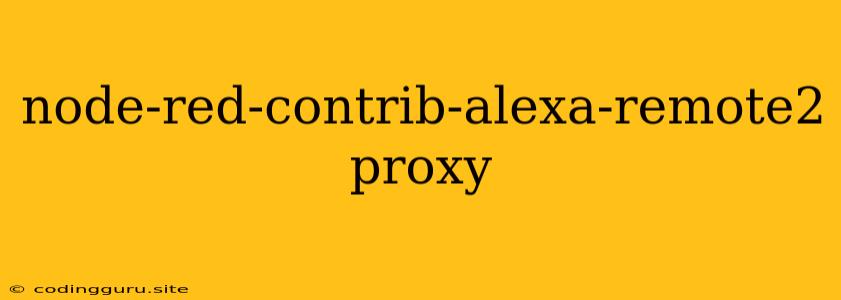Unlocking the Power of Your Alexa Devices with Node-RED: A Deep Dive into node-red-contrib-alexa-remote2 and Proxies
The world of smart home automation is constantly evolving, and Amazon's Alexa has become a cornerstone for many users. But what if you could extend the capabilities of your Alexa devices beyond their pre-programmed functionalities? Enter node-red-contrib-alexa-remote2, a powerful Node-RED node that allows you to seamlessly integrate your Alexa devices into your custom Node-RED workflows.
Node-RED, a visual programming tool, empowers users to create automated tasks and control various devices using a drag-and-drop interface. With node-red-contrib-alexa-remote2, you can unleash the full potential of your Alexa devices by sending commands, retrieving information, and integrating them with other elements within your smart home ecosystem.
What is Node-RED and Why Should I Use It?
Node-RED is a visual tool for creating automated tasks and workflows. It enables you to connect various devices and services, allowing for seamless communication and control.
Here's why Node-RED is a valuable tool for smart home automation enthusiasts:
- Visual Programming: Node-RED utilizes a drag-and-drop interface, making it easy to create workflows without writing complex code.
- Open-Source and Extensible: Node-RED is open-source, allowing for community contributions and a wide range of custom nodes, like node-red-contrib-alexa-remote2.
- Integration Power: Node-RED allows you to connect various devices, services, and platforms, including Alexa, MQTT, and even your own custom hardware.
Unlocking Alexa's Potential with node-red-contrib-alexa-remote2
node-red-contrib-alexa-remote2 is a Node-RED node that allows you to interact with your Alexa devices in a powerful and customizable way. With it, you can:
- Send commands to Alexa devices: Turn on lights, adjust thermostats, play music, and much more.
- Retrieve information from Alexa devices: Get the current status of your devices, like the temperature of a room or the volume of your music.
- Integrate Alexa devices with other services: Connect your Alexa devices to other platforms and tools, such as your home automation system or a weather API.
Example use case: Imagine you want to automate your home's lighting based on sunset times. With node-red-contrib-alexa-remote2, you can create a workflow that retrieves the sunset time from a weather API, then triggers a command to turn on your Alexa-controlled smart lights at dusk.
The Role of Proxies in Seamless Alexa Integration
For some users, direct communication between their Node-RED instances and their Alexa devices may not be feasible due to network configurations or security concerns. This is where proxies come into play. A proxy acts as an intermediary, allowing your Node-RED instance to communicate with your Alexa devices indirectly.
Here's how proxies enhance your Alexa integration with Node-RED:
- Security: Proxies can add a layer of security by acting as a firewall, preventing unauthorized access to your Alexa devices.
- Network Flexibility: Proxies allow you to connect your Node-RED instance to your Alexa devices even if they are on different networks.
- Enhanced Control: Proxies can be configured to control the communication flow between Node-RED and Alexa, ensuring privacy and data security.
Getting Started with node-red-contrib-alexa-remote2 and Proxies
Here's a step-by-step guide on how to utilize node-red-contrib-alexa-remote2 and proxies to control your Alexa devices:
- Install Node-RED: Download and install Node-RED from the official website.
- Install node-red-contrib-alexa-remote2: Open Node-RED's palette manager and search for "node-red-contrib-alexa-remote2". Install the node.
- Configure Alexa Skills: Set up the necessary skills in your Alexa app for the devices you want to control.
- Set up a Proxy (if needed): If you require a proxy, choose a suitable proxy solution, such as Nginx or Apache, and configure it for your specific network setup.
- Configure node-red-contrib-alexa-remote2: Within Node-RED, configure the node-red-contrib-alexa-remote2 node with your Alexa credentials and the proxy details (if applicable).
- Build Your Workflow: Create a workflow using various nodes, including node-red-contrib-alexa-remote2, to automate your desired tasks.
Remember: You can find detailed installation instructions and examples in the node-red-contrib-alexa-remote2 documentation.
Conclusion
node-red-contrib-alexa-remote2 offers a powerful and flexible solution for extending the functionality of your Alexa devices within your Node-RED workflows. With the added flexibility of proxies, you can seamlessly integrate your Alexa devices into your smart home automation system, unlocking a world of possibilities for customized control and automation. Enjoy the journey of building your own smart home solutions!
